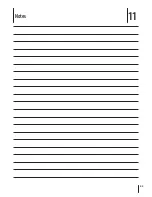
S
ection
6— M
aintenance
& a
djuStMentS
30
Tractor Storage
If your tractor is not going to be operated for an extended period
of time (thirty days to approximately six months), the tractor
should be prepared for storage. Store the tractor in a dry and
protected location. If stored outside, cover the tractor (including
the tires) to protect it from the elements. The procedures
outlined below should be performed whenever the tractor is
placed in storage.
1.
Change the engine oil and filter following the instructions
provided in the engine manual.
WARNING!
Never store the tractor with fuel in the
tank indoors or in poorly ventilated enclosures, where
fuel fumes may reach an open flame, spark or pilot
light as on a furnace, water heater, clothes dryer, etc.
2.
Service the engine as instructed in the seperate engine
manual.
3.
Engines stored between 30 and 90 days need to be treated
with a gasoline stabilizer such as
STA-BIL®
and engines
stored over 90 days need to be drained of fuel to prevent
deterioration and gum from forming in fuel system or on
essential carburetor parts. If the gasoline in your engine
deteriorates during storage, you may need to have the
carburetor, and other fuel system components, serviced or
replaced.
WARNING!
Fuel left in the fuel tank deteriorates
and will cause serious starting problems.
3.
Remove the spark plugs and pour approximately one
ounce of oil into each cylinder. Crank the engine one or
two turns to spread the oil evenly on the cylinder walls.
Replace the spark plugs.
4.
Clean the engine and the entire tractor thoroughly.
NOTE:
Use of a pressure washer or garden hose is not
recommended to clean your tractor. This may cause
damage to electrical components, spindles, pulleys,
bearings or the engine. The use of water will result in
shortened life and reduce serviceability.
5.
Sharpen the blades so that the mower will be ready to use
when needed.
6.
Protect the metal surfaces. Repair scratches with the
appropriate touch-up spray paint. Brush a rust preventive
oil on any unpainted surfaces including the pulleys and
blades. (Be careful not to get any oil on the drive belts.)
7.
Clean and fully charge the battery, then disconnect the
negative cable at the battery to prevent possible discharge.
Recharge the battery periodically when in storage.
NOTE:
Remove the battery if exposed to prolonged periods
of sub-freezing temperatures. Store in a cool, dry location
where temperatures are above freezing.
8.
Lubricate all lubrication points.
9.
Inspect the hydraulic hoses, lines and fittings. Replace as
necessary.
10.
Jack the mower up and store it on blocks to take the weight
off of the tires.
Removing The Tractor From Storage
1.
Check the battery. Charge if necessary.
2.
Lower tractor off blocks, and inflate the tires to the
recommended pressure.
3.
Remove the spark plugs and wipe them off. Using the starter,
crank the engine to pump the excess oil out of the spark
plug holes. Replace the spark plugs and the ignition leads.
4.
If drained before storing, fill the fuel tank with clean, fresh
gasoline.
5.
Check the level of the engine oil in the crankcase and the
hydraulic reservoir tank.
6.
Start the engine and allow to idle for a few minutes to
ensure engine is operating properly.
7.
Drive the tractor without a load to make certain all the
tractor systems are functioning properly.
Adjustments
Seat
Refer to the Assembly & Set-Up section for instructions on
adjusting the seat.
Steering Wheel Column
Refer to the Assembly & Set-Up section for instructions on
adjusting the steering wheel.
Leveling the Mower Deck
When correctly adjusted the mower deck should be level side to
side, and the front of the deck should be approximately 1⁄4” lower
than the rear of deck.
NOTE:
Check the tractor’s tire pressure before performing any
deck leveling adjustments. See Tires on page 28 for proper
inflation pressures.
Side-to-Side Leveling
1.
Park the mower on a flat paved surface, engage the parking
brake, shut off the engine, remove the key from the ignition
switch, disconnect the spark plug wires, using the deck lift
pedal position the mowing deck into the 4” height of cut
position (the 4” height of cut position is recommended
in order for one to see and obtain a measurement. Any
height of cut position is acceptable as long as a proper
measurement can be taken) and rotate both outside blades
so that they are perpendicular with the tractor.
2.
Measure the distance from the outside of the left blade
tip to the ground and the distance from the outside of the
right blade tip to the ground. Both measurements taken
should be equal. If they’re not, proceed to the next step.
















































